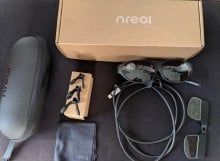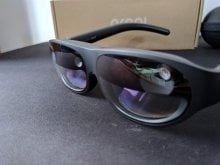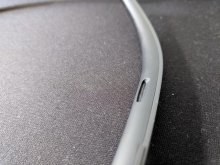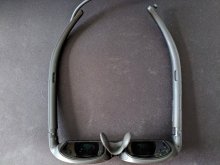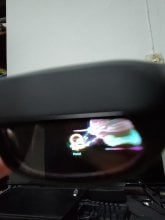Nreal Light Impression
“Get out of there, move!” throws a battle-worn Iron Man-lookalike, briefly glancing in my direction, before disappearing through a portal. I glance to my right and find no one. I repeat the action to my left and again see no one. This is when I realize this advice was actually meant for me. Heeding to the Tony Stark-wannabe’s command, I make my way cautiously towards the portal and walk through it.
Once past the circular gateway, I am greeted by some distant firing sounds and howling wind as I take in the new landscape: an endless expanse of space (where sound should technically not travel) in which it appears that I’m now floating and spaceships are firing at each other in the distance. Looking around, I find our high-tech superhero drifting in the vast vacuum, lifeless. I can’t mourn his loss for long as an asteroid comes hurtling my way.
I dodge and watch it continue its course past me. I wonder if I can interact with these space artefacts somehow; and fiddling around, I learn that I can fire shots. So off I go blasting asteroids to pieces until my gaze stops on the lifeless Iron Man-clone whom I already forgot about in my asteroid-blasting spree. The urge is too strong; I aim and shoot at the poor armored suit which flips on impact of my shots.
Looking around for other targets, I notice another portal in the distance to my right. Intrigued as to where it might lead, I make my way in its direction only to stop short because of the limits of the room I’m in. That’s when I decide to take off the Nreal Light and recommend everyone in the house to try it.
What I just shared was my experience with a mixed reality demo game on the Nreal Light smart glasses which I had the opportunity to test. These aren’t glasses like the Vue or Mutrics which are essentially mini bluetooth speakers in glass frames. The Nreal Light also features speakers in each of its arms (which deliver good audio quality by the way) but it doesn’t stop with audio features. Rather, the Nreal light is a mixed reality (MR) pair of glasses that look like regular sunglasses. Consumer kits are already available in a few markets, namely South Korea and Japan, but the unit I received was a demo of sorts and doesn’t reflect the full consumer experience; hence this being an impression piece rather than a full review. But the hardware shouldn’t be different and currently packs the following specs:
Specification
- Dimension: 146mm x 175mm x 44mm (unfolded), 156mm x 52mm x 44mm (folded)
- Weight: 106g
- Optics: Compound Lightguide
- Spatial Computing: 6DoF spatial tracking, Plane recognition, Image recognition
- Audio: Dual speakers, Dual microphones
- Sensors: 2 spatial computing cameras, Photo/HD video RGB camera, IMU (Accelerometer, Gyroscope), Ambient light sensor, Proximity sensor
- Connectivity: USB-C, Compatible with devices equipped with a full-function USB-C port.
- Button: Brightness: Increase/Decrease the brightness of display
The glasses use a similar technology to the MAD Gaze GLOW Plus that I reviewed before and you will see several such MR devices available for consumers in the coming months and years, especially from companies based in China. These sunglass-looking devices require a tethered connection to a smartphone in order to operate. They are, in fact, wholly dependent on a phone as it provides all of the processing power and the glasses don’t even feature a battery. This allows the Nreal Light to be compact and lightweight (for a pair of MR glasses) at 106g.
Regarding the build quality, I am very satisfied with what these smart glasses have to offer. While light, they are of a sturdy build. They look sleek, with a matte finish, with flexible hinges at the arms, making them fit a wider range of face size. At the end of the left arm, the USB-C cable protrudes but I wish it was detachable for easier storage and it could also be replaced in case of damage. There’s a hook at the end of the right arm where you can clip the cable and somewhat secure the glasses at the back of your head.
While the Nreal Light mostly looks like regular sunglasses, there are features that will make it standout upon closer look. Firstly, there is a pair of spatial computing cameras and a camera for pictures and videos in front, which are definitely not features of regular sunglasses. But Nreal does have a “VR Cover” that blocks those cameras and sensors altogether (I did not have access to one, so I can't comment much on it). Then there’s the fact that they stick a bit towards the front due to the nose pads. The Nreal Light comes with a couple of those pads to adjust to your nose bridge size and to your liking. You can also remove the pads as they are easily removable by simply pulling on them.
On the inner side of the frames is an IR sensor that faces the forehead when worn and puts the screen to sleep when you take it off. I was relieved to see that Nreal accommodated for bespectacled people like me and have a prescription lens insert that magnetically clips to the inner side of the frames.
Overall the Nreal Light is comfortable to wear, and definitely of a superior build quality than the other consumer MR headset I tested, the MAD Gaze GLOW Plus; and it shows that much thought was given into designing the Nreal’s first pair of consumer MR glasses.
Moreover, unlike the GLOW Plus which suffers from a dearth of dedicated apps, the Nreal Light is in no shortage of apps. Via the Nebula app, a dedicated MR launcher of sorts, you can launch any app that is already on your phone. Unlike the GLOW Plus, the Nreal Light does not simply mirror your phone’s screen so that you have a static, floating screen glued to your eyes. Instead, from the Nebula launcher, apps open in a separate window which you can ‘stick’ on a 360-degree virtual canvas that allows you to reposition, resize and adjust the window’s distance from your eyes practically anywhere around you (even on the ceiling and floor). Those windows will remain stuck in the location you placed them, even if you move around; superimposed to the real-world environment you are in (even if the Nreal Light looks like sunglasses, the lenses are translucent and lightly tinted, hence allowing you to see your surroundings).
However, only 3 apps (or windows) can be opened at a time but I hope future updates bump up that number (MAD Gaze’s glasses already allows up to 7 apps to be open simultaneously). But while MAD Gaze’s AR Launcher app allows more windows to be open, it only supports a few apps in its launcher. On top of that, you must sign in again, regardless of whether you already have the same app on your phone and are signed in there. Nreal’s Nebula launcher opens the app that’s already on your phone just as you would use it on your phone’s screen. That’s why the Nreal Light won’t lack apps as its launcher practically brings the whole Android ecosystem to its platform. In essence, they work as an external monitor with fancy features.
In terms of visuals, the Nreal Light offfers crisp 1080p images with a 52º FOV (which beats that of some of the biggest players in the MR field like Magic Leap and even the original HoloLens). While that might not sound much in comparison to VR headsets, adjusting the size of windows and well-designed apps offer a pretty ‘convincing holographic’ experience. If an image/object is outside the field of view, it feels like you are looking through a rectangular scope and can catch the rest of the image by moving around. The display is bright and best appreciated in an indoors setting while if you are wearing these outside, the display will be rather poorly visible, even with the brightness settings cranked way up. I took the image below from the Nreal Light to give you an idea of the image quality and how it superimposes on the actual surroundings:
Unfortunately, the demo unit I was given access to does not support video capture, so I cannot share my experience. I really hope that the retail unit comes bundled with this feature so that users can share their MR sights as well. However, it is practically the same as depicted in the official video below; fluid, seamless and at a crisp 1080p:
As for controls, they are performed by using your phone as a laser pointer and controller. You point it at the window you want to use and scroll down on the touchscreen to scroll down the app. To select something, you just tap on the touchscreen after aiming with the pointer. It’s easy and accurate, although sometimes the phone’s position can be off. But that’s easily fixed by holding on the ‘Home’ button that shows up on your phone’s screen to recenter the pointer to where you are looking. These controls are rather intuitive and require a minimal learning curve to get into mixed reality.
While there is a virtual keyboard that appears in MR mode, it’s rather painful to type word after word using the pointer and tapping. Chi Xu, Nreal’s founder, said that hand tracking is coming soon, and I really hope they can implement typing with this feature! For now, the best solution I found is to pair the phone with a physical Bluetooth keyboard. With this method, I even typed part of this article while having music videos playing on YouTube and occasionally browsing the web for news. This seamless multitasking ability works really great and since it’s compatible with practically any existing app, Nreal Light makes a pretty convincing case for everyday MR use.
While preinstalled apps work, there are also dedicated apps for the Nreal Light as well. The example I gave while beginning this article is the ‘Portal’ demo from one such app called ‘Infinity Space’. It’s a tech demo of sorts with 6 demos included. Aside from Portal, there’s an ‘AR Cinema’ with a couple of clips, including a 3D one with some effects that make on-screen objects seem to pop out and come at you. Then there’s ‘Lovely Cat’ which puts a holographic cat in your environment and does what cats do best: follow laser pointers (your phone works as one). This one’s really cute and makes me wish for an MR tamagotchi app (please make it happen!). ‘Butterfly Valley’ shows a virtual diorama, around which you can move and take in the details while butterflies flutter around. ‘Holographic Video’ shows a bunch of CGI animations that work like videos you can view from any angle while the ‘action scene’ stays in place. Finally there’s ‘AR Dance’ which puts 3 Hatsune Miku-like idols performing a choreographed dance and you can reposition and resize those virtual performers and walk around them (or maybe join them, who’s to judge?!). Again I don’t have videos from my point of view but you can catch similar glimpses from the official teaser below:
These are tech demos and are meant to impress but also give an idea regarding what’s possible with the technology. I also had access to another tech demo called ‘TV Program’ which features an ultra-ultra-wide 360 circular screen with mini-screens to select a trailer from which will then play on a 220” virtual screen. While it’s just a demo, I hope the consumer Nebula app will include such a media player allowing users to load up their own videos to view on such an immersive screen from such a portable device.
Other than the Nebula launcher, the other, full-fledged app developed by Nreal is a tower defense game called Nreal Tower. It was developed as a sample to help developers make their own games but I could not try it myself on the demo kit I tested. I hope that more first-party apps come to the device to flesh out the potential of these smart glasses.
Nevertheless, there are several apps in the works by the active Nreal developer community since the company launched its dev kit and opened up its Unity-based SDK. There are some promising ones like a ghost hunting game and a 3D Bing Map. These are mostly demos and are still works-in-progress but do show that there is an active community developing dedicated software for the product.
But Nreal has also been busy partnering with other companies to bring their software to the device. There’s the virtual workspace Spatial which I have tried and is quite impressive even in Beta mode. It’s a really futuristic MR experience with my room’s walls turning into huge workspaces for sticky notes, Slack updates from work and it even allows a ‘holographic’ conferencing of sorts. This app proved to be one of the best experiences I've had that really highlights a use case for productivity.
Then there’s STYLY that’s a social media app of sorts for artists to share their VR/AR scenes. Some are very impressive like 3D VR mangas that help depict known media from a different perspective. There are other apps as well but are restricted to the markets the Nreal Light is currently available in; hence, my experience is relatively limited.
However, my experience with the Nreal Light gave me a pretty good indication as to where the device is going. It’s a convincing statement that MR is ready for wide adoption and neatly integrates with the ecosystem we’re used to. It’s not going to replace how we use our smartphones but rather aims to supplement it with novel ways to interact with it. Those smart glasses aren’t meant to be worn the whole day (although you easily could) but are adequate to slip on and off throughout the day to have a quick virtual team meeting or browse through your social media feeds on a widescreen while you are commuting.
Of course, it’s quite niche, and might evolve to resemble something akin to the VR market, but Nreal seriously wants to make consumer MR a reality. From what I’ve seen during my time with it, it’s well on track to make it happen; if it hasn’t already. And I’ve only tested a handful of apps and mostly demos! It is expected to launch in European markets later this year, starting with Germany and Spain via Vodafone; and we’ll likely hear more about dedicated and compatible apps closer to Western launch.
While Nreal is trying to bring MR to the masses, there are a few caveats with its device. Firstly, the rollout is rather slow (or overly cautious) being available in limited markets and tied to only specific carriers. Then there’s the fact that the headset needs a phone with Snapdragon 845 and above to function (although there might be sideloading workarounds with Android but these won’t be fully supported and might lack some features). It is also designed to take advantage of a 5G connection, although offline use is possible. Such a phone will add to the price (if you don’t have one of the few that the carrier supports) and the Nreal headset itself isn’t exactly cheap. In South Korea, it is available for around $586 while in Japan, the cost is around $663; so expect a similar price range for Western markets, unless it comes in a bundle with a smartphone. But even then, the Nreal Light costs a fraction of other high-end MR devices on the market ($3,500 for the HoloLens 2 and $2,295 for the Magic Leap 1).
Additionally, the phone itself gets hot after extended use and while in MR mode, the battery drains rather fast. It’s not just the phone that heats up but also the smart glasses including its legs; but it’s bearable and not as hot as the MAD Gaze GLOW Plus gets.
Of note, it can get tiring to keep using the phone as a controller for long as it can feel heavy with time. I hope that the hand tracking feature will be ready when it launches in other markets and takes the need to use the phone as a controller for basic use away.
I also wish there were additional buttons on the glasses' arms to control audio volume as those on the right arm only control brightness. This means that in order to adjust volume, you still have to rely on the phone which is not very optimal.
However, if you have a compatible phone, can bear with those caveats and want to experience mixed reality but don’t have the budget for a HoloLens or a Magic Leap, then the Nreal Light will surely deliver an exciting and memorable experience. But I’m only sharing my thoughts based on basic demos and a few apps. But given how Nreal has been partnering with several companies to port their apps to the platform, the Nreal Light might soon offer a compelling ecosystem which will be worth keeping an eye on. The progress they made as a startup from both the hardware and software side is rather impressive, especially considering that the Nreal Light is their first device.
Previously I saw a reporter term Nreal’s headset as “the poor man’s Magic Leap” (Chi Xu was a former Magic Leap employee, so the comparisons are inevitable). While they are definitely more affordable, the Nreal Light could very well shape up to become known as everybody’s MR glasses.
